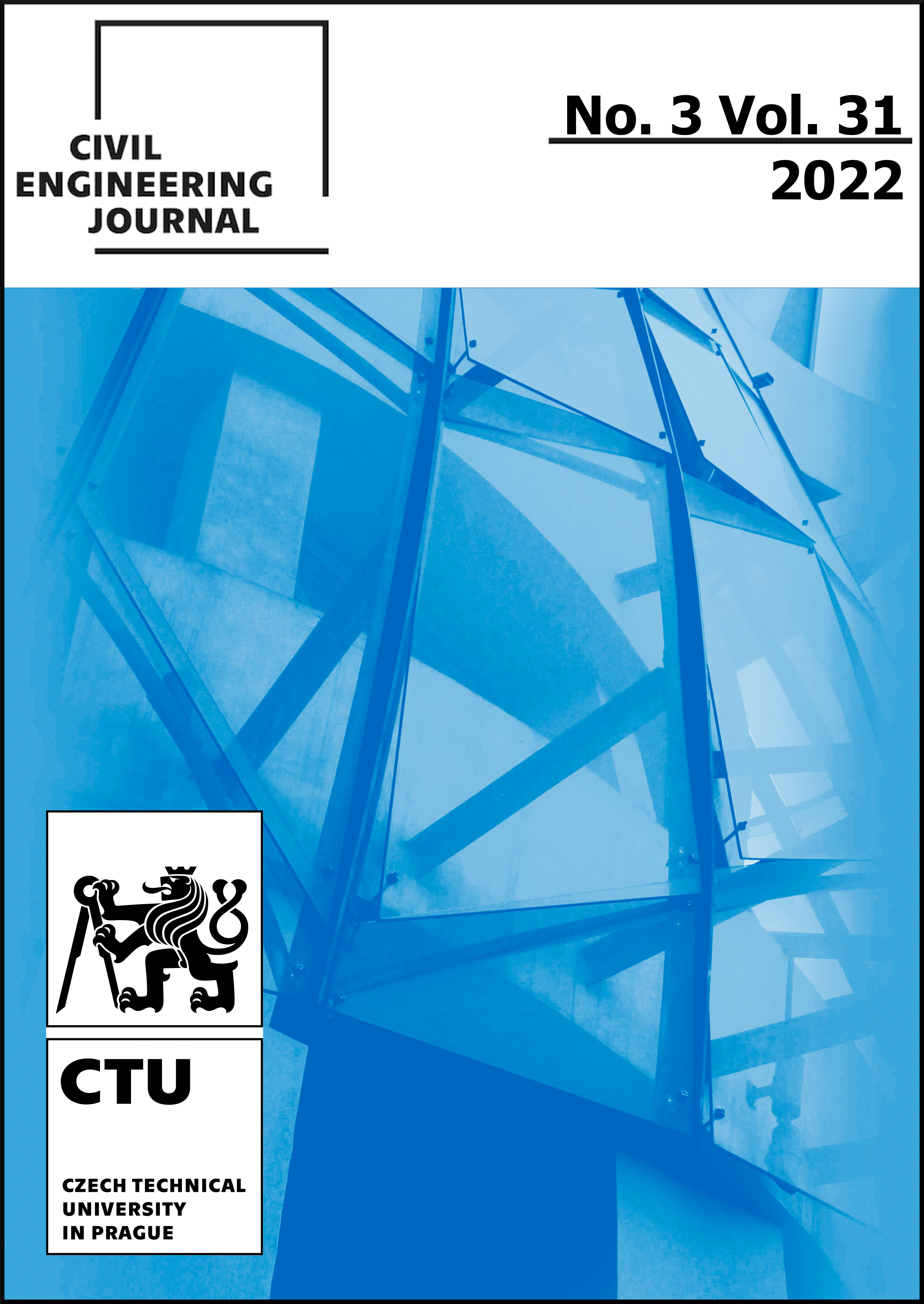Mechanical characteristics and deformation law of tunnel in diatomite considering various softening conditions
DOI:
https://doi.org/10.14311/CEJ.2022.03.0038%20Keywords:
High-speed railway tunnel, diatomite layer, softening degree, deformation law, mechanical characteristicAbstract
At present, the research considering multi-factor softening conditions is rarely performed, and the research on the deformation law and mechanical properties of the tunnel in diatomite is even rarer. Diatomite is easy to soften in water, and its physical and mechanical properties change greatly after softening. Therefore, take the high-speed railway tunnel that passes through the diatomite stratum in East China as an example, considering various softening conditions (including softening degree and softening position), the deformation law and mechanical characteristics of the tunnel are obtained, and corresponding suggestions are also put forward according to different softening conditions. The results show that the deformation law and mechanical characteristics of the tunnel are greatly affected by the symmetry of softening part. The deformation of the inverted arch caused by the lower surrounding rock softening of the tunnel is the largest, and the maximum stress occurs at the arch foot when the upper surrounding rock of the tunnel softens. Different softening degrees and positions have a great influence on the mechanical characteristics and deformation law of the tunnel. The results obtained in this paper may provide some important references for similar projects in the future.
Downloads
References
Zhang, Y.S., Guo, C.B., Qu, Y.X., et al 2012. Discovery of swelling diatomite at Tengchong, Yunnan province and its implication in engineering geology. Journal of Engineering Geology, Vol. 20, 266-275.
Li, P.F., (2013). Experimental investigation on the stress-strain characteristics of diatomite. Master’s Thesis, Dalian University of Technology, Dalian.
Tran, T. M. and Nguyen, Q. H., 2021. Effect of blasting on the stability of lining during excavation of new tunnel near the existing tunnel. Civil Engineering Journal, Vol. 301, 47-62. https://doi.org/10.14311/CEJ.2021.01.0004
Guo, J.Q., Wu, W.L., Liu, X.L., et al, 2022. Theoretical analysis on safety thickness of the water-resistant rock mass of karst tunnel face taking into account seepage effect. Geotechnical and Geological Engineering, Vol. 40, 697-709. https://doi.org/10.1007/s10706-021-01916-7
Hong, Z.S., Li, S.Y.X., Deng, Y.F., 2004. Relationship between entrance pore distribution and stress level of natural sedimentary diatomaceous soil. Rock and Soil Mechanics, 1023-1026.
Hong, Z.S., Li, S.Y.X., Deng, Y.F., 2004. Mechanical behavior of a strongly-structured natural sedimentary soil. Rock and Soil Mechanics, 1201-1204. https://doi.org/10.16285/j.rsm.2004.08.005
Fang, Y.Y., Jiang, J., Jiang, H.H., 2019. Research on the microstructure and the mechanical properties of Shengzhou diatomite. Low Temperature Architecture Technology, Vol. 41, 75-77. https://doi.org/10.13905/j.cnki.dwjz.2019.02.021
Wang, Y.X., Ji, F., Gu, H.D., et al, 2017. Fractal characteristics of natural sedimentary diatomaceous earth based on SEM images. Hydro-science and Engineering, 96-102. https://doi.org/10.16198/j.cnki.1009-640x.2017.05.014
Guo, C.B., Zhou, N.J., Fu, X.X., et al, 2013. The optimization design of the research on the formation mechanism, prevention and control of landslide along clayey diatomite highway in Tengchong, Yunnan Province. Geological Bulletin of China, Vol. 32, 2021-2030.
Guo, Y.K., Ma, Q.H., Guo, Z.S., 2018. Numerical analysis of tunnel deformation and stress behavior of support under rainfall infiltration. Journal of Civil Engineering and Management, Vol. 35, 52-57. https://doi.org/10.13579/j.cnki.2095-0985.2018.04.008
Zhang, Y.S., Guo, C.B., Qu, Y.X., et al, 2013. Research on mechanical properties of swelling diatomite and their geohazard effects. Rock and Soil Mechanics, Vol. 34, 23-30. https://doi.org/10.16285/j.rsm.2013.01.024
Zhang, R. and Yang, X.L., 2018. Limit analysis of active and passive mechanisms of shallow tunnels in nonassociative soil with changing water table. International Journal of Geomechanics, Vol. 18, 04018063. https://doi.org/10.1061/(ASCE)GM.1943-5622.0001167
Fan, S.Y., Song, Z.P., Zhang, Y.W., et al, 2020. Case study of the effect of rainfall infiltration on a tunnel underlying the roadbed slope with weak inter-layer. KSCE Journal of Civil Engineering, Vol. 24, 1607-1619. https://doi.org/10.1007/s12205-020-1165-0
Wang, X.D., 2018. Deformation characteristics and construction method for large section loess tunnel with high water content. Railway Engineering, Vol. 58, 59-61.
Wang, Z.J. and Yang, Y., 2017. Research on effect of moisture content on initial support safety of large cross-section tunnel in Xigeda Fm strata. Railway Standard Design, Vol. 61, 100-105. https://doi.org/10.13238/j.issn.1004-2954.2017.11.021
Zhou, P., Wang, Z.J., Xu, H.Y., et al, 2017. Stability and sub-classification study on the tunnel surrounding rock of Xigeda strata considering the influence of moisture content. China Civil Engineering Journal, Vol. 50, 97-110. https://doi.org/10.15951/j.tmgcxb.2017.12.012
Ye, W.J., Cui, C.Y., Xie, Z.W., et al, 2019. Influence of water content difference on construction mechanical behavior of expansive red clay tunnel. Tunnel Construction, Vol. 39, 1940-1948.
Gao, H.X., Yin, K.L., Zhou, C.M., 2007. Diatomite landslides stability analysis and time forecast. Journal of Northwest University, 127-130.
Wu, B., Gao, B., Suo, X.M., et al, 2005. Mechanical simulation and analysis of construction behavior of urban metro tunnelling with small interval. China Journal of Highway and Transport, 84-89. https://doi.org/10.19721/j.cnki.1001-7372.2005.03.019
Downloads
Published
Issue
Section
License
Copyright (c) 2022 Author

This work is licensed under a Creative Commons Attribution-NonCommercial 4.0 International License.
Authors who publish with this journal agree to the following terms:
- Authors retain copyright and grant the journal right of first publication with the work simultaneously licensed under a Creative Commons Attribution License that allows others to share the work with an acknowledgement of the work's authorship and initial publication in this journal.
- Authors are able to enter into separate, additional contractual arrangements for the non-exclusive distribution of the journal's published version of the work (e.g., post it to an institutional repository or publish it in a book), with an acknowledgement of its initial publication in this journal.
- Authors are permitted and encouraged to post their work online (e.g., in institutional repositories or on their website) prior to and during the submission process, as it can lead to productive exchanges, as well as earlier and greater citation of published work (See The Effect of Open Access).
How to Cite
Accepted 2022-09-27
Published 2022-10-30











